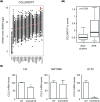ERK1/2 signaling regulates the immune microenvironment and macrophage recruitment in glioblastoma
- PMID: 31467175
- PMCID: PMC6744584
- DOI: 10.1042/BSR20191433
ERK1/2 signaling regulates the immune microenvironment and macrophage recruitment in glioblastoma
Abstract
The tumor microenvironment is an important determinant of glioblastoma (GBM) progression and response to treatment. How oncogenic signaling in GBM cells modulates the composition of the tumor microenvironment and its activation is unclear. We aimed to explore the potential local immunoregulatory function of ERK1/2 signaling in GBM. Using proteomic and transcriptomic data (RNA seq) available for GBM tumors from The Cancer Genome Atlas (TCGA), we show that GBM with high levels of phosphorylated ERK1/2 have increased infiltration of tumor-associated macrophages (TAM) with a non-inflammatory M2 polarization. Using three human GBM cell lines in culture, we confirmed the existence of ERK1/2-dependent regulation of the production of the macrophage chemoattractant CCL2/MCP1. In contrast with this positive regulation of TAM recruitment, we found no evidence of a direct effect of ERK1/2 signaling on two other important aspects of TAM regulation by GBM cells: (1) the expression of the immune checkpoint ligands PD-L1 and PD-L2, expressed at high mRNA levels in GBM compared with other solid tumors; (2) the production of the tumor metabolite lactate recently reported to dampen tumor immunity by interacting with the receptor GPR65 present on the surface of TAM. Taken together, our observations suggest that ERK1/2 signaling regulates the recruitment of TAM in the GBM microenvironment. These findings highlight some potentially important particularities of the immune microenvironment in GBM and could provide an explanation for the recent observation that GBM with activated ERK1/2 signaling may respond better to anti-PD1 therapeutics.
Keywords: CCL2/MCP1; ERK1/2; Glioblastoma; Immune checkpoints; The Cancer Genome Atlas; Tumour-associated macrophages.
© 2019 The Author(s).
Conflict of interest statement
The authors declare that there are no competing interests associated with the manuscript.
Figures






References
-
- Reardon D.A., Ligon K.L., Chiocca E.A. and Wen P.Y. (2015) One size should not fit all: advancing toward personalized glioblastoma therapy. Discov. Med 19, 471–477 - PubMed
Publication types
MeSH terms
Substances
LinkOut - more resources
Full Text Sources
Research Materials
Miscellaneous

